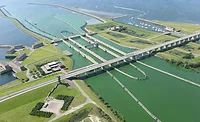Prepaint Has Bright Future in Renewable Energy
CLEVELAND - Coil coating is the method of choice for applying many types of coatings in a wide variety of industries. Now it’s being used to apply coatings that help capture the power of the sun. Coil coating is being used to apply selective absorber coatings to aluminum strip for thermal energy applications at solar power plants. The process provides the precise layers of coatings needed for high-performing solar absorber coatings.
The coil coating process is ideal for specialty coatings used for solar energy because of the optimal surface prep, coating adhesion and continuous control that are unique to this process.
By using the coil coating process, thin coatings can be uniformly applied to metal strip, so that a highly selective coating and several functional coats can be applied in very precise thin layers. The functional coats often include functional particles, such as nano-particles, metal particles, metallic oxide particles and pigments. Each coat has a job. For example, one layer may absorb short-wave solar radiation while also being transparent for long-wave radiant heat. The result is conduction of short-wave solar radiation converted into long-wave radiant heat, so that the absorber plate is heated up as needed. Outside coats can be reflective for radiant heat, so that the absorbent coat emits little radiant heat to the outside. Additional coating layers provide humidity and temperature resistance to protect against corrosion. Other layers provide adhesion promoter properties, which substantially improve the endurance of the coating in the intense sun.
With the coil coating process, the coating thickness can be adjusted precisely by means of the gravure on the roller coaters and relative speed of line coil coating line. After coating, it is also possible to apply embossing to the painted metal, in order to increase the absorbent surface without tears developing in the coating.
In addition, the coil coating process makes it possible to produce absorber panels at a much lower cost than previously necessary PVD or CVD processes. This is because capital outlay for a cost-intensive vacuum technology required with other processes is not necessary with the considerably higher coating speeds achieved with the coil coating process.
The coil coating process is ideal for specialty coatings used for solar energy because of the optimal surface prep, coating adhesion and continuous control that are unique to this process.
By using the coil coating process, thin coatings can be uniformly applied to metal strip, so that a highly selective coating and several functional coats can be applied in very precise thin layers. The functional coats often include functional particles, such as nano-particles, metal particles, metallic oxide particles and pigments. Each coat has a job. For example, one layer may absorb short-wave solar radiation while also being transparent for long-wave radiant heat. The result is conduction of short-wave solar radiation converted into long-wave radiant heat, so that the absorber plate is heated up as needed. Outside coats can be reflective for radiant heat, so that the absorbent coat emits little radiant heat to the outside. Additional coating layers provide humidity and temperature resistance to protect against corrosion. Other layers provide adhesion promoter properties, which substantially improve the endurance of the coating in the intense sun.
With the coil coating process, the coating thickness can be adjusted precisely by means of the gravure on the roller coaters and relative speed of line coil coating line. After coating, it is also possible to apply embossing to the painted metal, in order to increase the absorbent surface without tears developing in the coating.
In addition, the coil coating process makes it possible to produce absorber panels at a much lower cost than previously necessary PVD or CVD processes. This is because capital outlay for a cost-intensive vacuum technology required with other processes is not necessary with the considerably higher coating speeds achieved with the coil coating process.
Looking for a reprint of this article?
From high-res PDFs to custom plaques, order your copy today!







